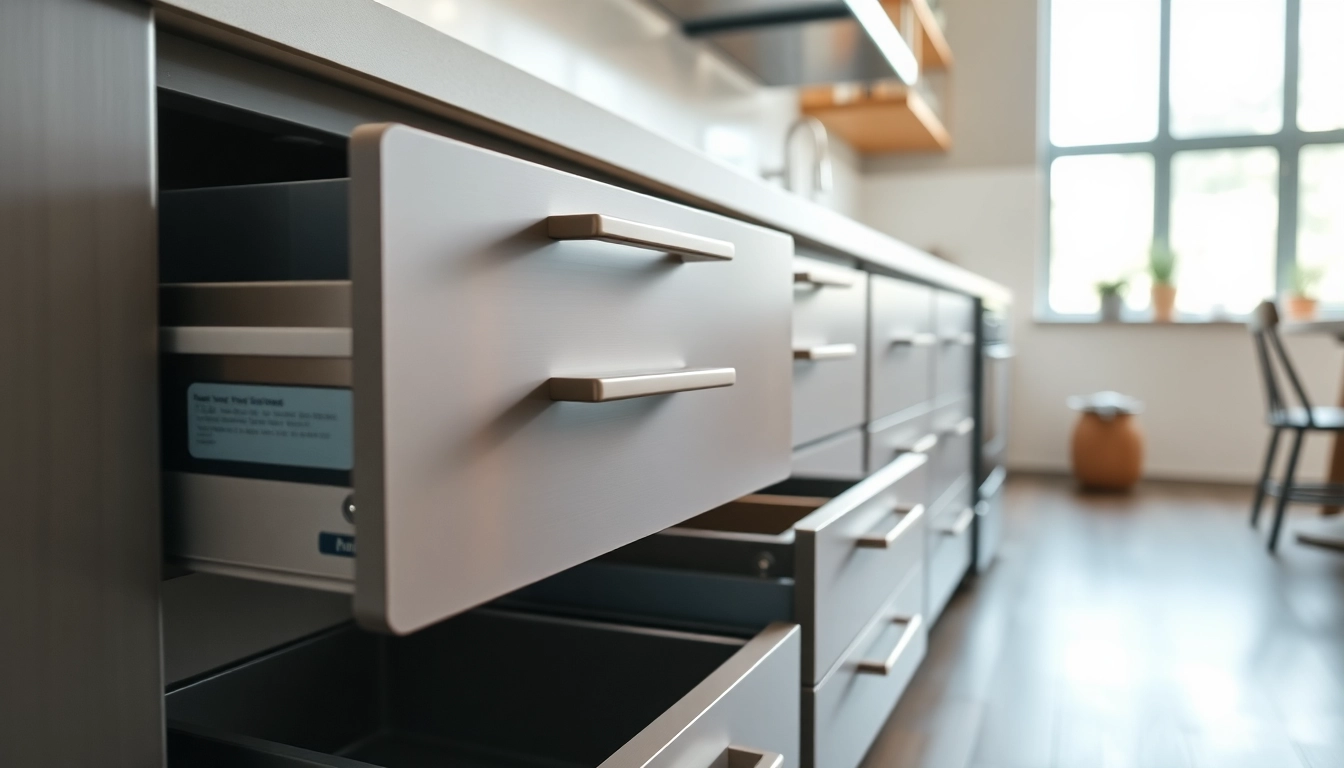Understanding Metal Drawer Systems
In the ever-evolving world of home and office furniture, the importance of a functional storage solution cannot be overstated. Among the myriad options available, the metal drawer system stands out for its durability, versatility, and aesthetic appeal. These systems are ideal for a wide range of applications, from residential cabinets to industrial storage units. In this article, we will explore the intricacies of metal drawer systems, including their components, benefits, installation processes, and maintenance tips, to help you determine why they should be your storage solution of choice.
What is a Metal Drawer System?
A metal drawer system is a mechanical assembly designed to provide secure, easy access to stored items within a variety of contexts, from kitchens and bathrooms to industrial workspaces. Constructed primarily from high-quality metal materials, these drawer systems offer superior strength compared to their wooden counterparts, making them a preferred choice for heavy-duty applications.
Components and Specifications
At their core, metal drawer systems typically consist of the following components:
- Drawer Box: The main storage unit, often made from steel or aluminum, designed for optimal strength and durability.
- Drawer Slide Mechanism: Includes various types such as side-mounted, undermount, or full-extension options that allow the drawer to glide in and out smoothly.
- Front Panel: This is the visible part of the drawer and often customizable to match cabinetry styles.
- Installation Hardware: Necessary brackets, screws, and other fasteners used to secure the drawer system in place.
Specifications may vary depending on the brand and intended use, but metal drawer systems typically carry weight ratings that indicate their load-bearing capacity, which can range from 75 pounds to over 200 pounds.
Benefits of Using Metal Drawer Systems
Metal drawer systems offer an array of advantages that make them a superior choice for many users:
- Durability: Metal is inherently more robust than wood, making these systems less susceptible to damage from daily use, moisture, and pests.
- Ease of Maintenance: They typically require less upkeep compared to wooden drawers, as metal surfaces can be easily cleaned and resist staining or warping.
- Space Efficiency: Many metal drawer systems utilize advanced sliding mechanisms that maximize storage space while maintaining a sleek appearance.
- Customization Options: Available in various colors and finishes, metal drawer systems can be tailored to complement any design aesthetic in your space.
- Cost-Effectiveness: While the initial investment may be higher, the longevity and reduced need for repairs often make metal drawer systems a financially wise choice over time.
Types of Metal Drawer Systems Available
Ball Bearing vs. Undermount Systems
When selecting a metal drawer system, the choice between ball bearing and undermount slides is pivotal:
- Ball Bearing Slides: These are designed with a series of ball bearings that reduce friction, allowing for smoother opening and closing. They are highly durable and ideal for heavy loads, making them perfect for kitchen and office applications.
- Undermount Slides: These slides are hidden beneath the drawer, providing a clean, minimalist look. They often feature soft-close mechanisms that automatically pull the drawer closed, preventing slamming and enhancing user experience.
Heavy-Duty Options for Increased Durability
For projects requiring maximum durability, heavy-duty metal drawer systems are available. These systems are designed to handle loads that exceed 200 pounds, ideal for commercial kitchens, garage storage, or any environment where robust performance is critical. Features may include reinforced construction and advanced locking mechanisms for added safety.
Soft-Close Mechanisms for Enhanced Functionality
One of the most desirable features in modern metal drawer systems is the soft-close mechanism, which gently brings the drawer to a close without noise or abrupt stops. This not only protects the drawer and its contents but also enhances the overall user experience. Many high-end brands incorporate adjustable dampers that allow users to customize the closing speed according to preference.
Installation Process for Metal Drawer Systems
Tools Required for Installation
Installing a metal drawer system can typically be performed with a few basic tools, including:
- Drill/Driver
- Screwdriver
- Level
- Tape Measure
- Clamps (optional)
- Safety Glasses
Step-by-Step Installation Guide
Follow these general steps for installing a metal drawer system:
- Measure and Mark: Determine the location of the drawer and mark the stud positions where the slides will be attached.
- Install the Drawer Slides: Attach the side or undermount slides to the marked locations using the screws provided.
- Assemble the Drawer Box: If you have purchased a kit, follow the manufacturer’s instructions to assemble the drawer box properly.
- Attach the Front Panel: Secure the front panel to the drawer box using screws, ensuring it is aligned correctly with the cabinet opening.
- Mount the Drawer: Slide the assembled drawer onto the installed slides and ensure it operates smoothly.
- Test and Adjust: Open and close the drawer. Adjust if necessary to ensure a perfect fit and function.
Common Mistakes to Avoid
While the installation of metal drawer systems is generally straightforward, several common mistakes can be avoided:
- Inaccurate measurements can lead to misalignment and operational issues.
- Neglecting to level the drawer leads to uneven operation.
- Forgetting to pre-drill holes can cause splits in the material.
Choosing the Right Metal Drawer System
Factors to Consider Before Purchase
Before selecting a metal drawer system, take into account the following factors:
- Weight Capacity: Assess the typical load you intend to place in the drawer and choose a system that can handle it.
- Dimensions: Ensure the drawer system fits within the intended space, both in height and width.
- Style and Finish: Consider the overall design of your space and opt for a finish that complements your decor.
- Ease of Installation: Some systems come with more complicated installation processes, requiring more time and tools.
Comparing Brands and Options
With numerous brands in the market, it’s essential to compare product features, warranty terms, and customer reviews. Leading brands such as Blum, Häfele, and Richelieu offer diverse lines with varying features tailored for both residential and commercial applications.
Cost vs. Value Analysis
The initial cost of a metal drawer system can vary widely. While lower-priced options may save money upfront, investing in a higher-quality system can lead to significant long-term savings due to durability and decreased need for replacement. Evaluate cost versus performance metrics to ensure you are making a sound decision.
Maintenance and Care for Your Metal Drawer System
Cleaning and Upkeep Tips
Maintaining your metal drawer system doesn’t require extensive effort but performing regular cleaning helps preserve its functionality and appearance:
- Wipe down the drawer surface with a soft cloth and mild detergent to remove dust and stains.
- Regularly inspect the slides for dirt or debris and clean them to ensure smooth operation.
- Avoid harsh chemicals that can damage the finish or accelerate rusting.
Troubleshooting Common Issues
Even the best metal drawer systems can encounter problems. Here are some common issues and solutions:
- Drawer Sticking: This may occur due to misalignment. Check the slides and adjust as needed.
- Drawers Not Closing Properly: Inspect the soft-close mechanism or any obstructions within the drawer.
- Noisy Operation: Lubricate the slides if they are emitting sound during use.
Extending the Lifespan of Your System
To maximize the longevity of your metal drawer system, consider these best practices:
- Avoid overloading the drawers beyond their rated capacity.
- Perform regular inspections to identify and rectify wear and tear before they become significant issues.
- Adjust the slides periodically to maintain optimal performance.
In conclusion, metal drawer systems represent a robust, stylish, and practical solution for all storage needs. With the right system in place, users can enjoy effortless access to their belongings, enhanced functionality, and a cleaner, more organized space.



